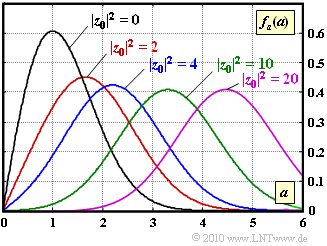Exercise 1.6: Autocorrelation Function and PDS with Rice Fading
One speaks of "Rice fading" if the complex factor describing the mobile radio channel contains $z(t)$ besides the purely stochastic component $x(t) +{\rm j} \cdot y(t)$ a deterministic part of the form $x_0 + {\rm j} \cdot y_0$ .
The equations of Rice fading can be summarized briefly as follows:
- $$r(t) = z(t) \cdot s(t) ,$$
- $$z(t) = x(t) + {\rm j} \cdot y(t) ,$$
- $$x(t) = u(t) + x_0 ,$$
- $$y(t) = v(t) + y_0 .$$
The following applies:
- The direct path is defined by the complex constant $z_0 = x_0 + {\rm j} \cdot y_0$. The magnitude of this time-invariant component is
- $$|z_0| = \sqrt{x_0^2 + y_0^2}\hspace{0.05cm}.$$
- $u(t)$ and $v(t)$ are zero-mean Gaussian random processes, both with variance $\sigma^2$ and uncorrelated with each other. They model scattering, refraction and diffraction effects on a variety of indirect paths.
- The magnitude $a(t) = |z(t)|$ has a Rice probability density function (PDF), which gives this channel model its name.
- For $a ≥ 0$, the PDF is
- $$f_a(a) = \frac{a}{\sigma^2} \cdot {\rm exp} [ -\frac{a^2 + |z_0|^2}{2\sigma^2}] \cdot {\rm I}_0 \left [ \frac{a \cdot |z_0|}{\sigma^2} \right ]\hspace{0.05cm}, \hspace{0.2cm}{\rm I }_0 (u) = \sum_{k = 0}^{\infty} \frac{ (u/2)^{2k}}{k! \cdot \Gamma (k+1)} \hspace{0.05cm}.$$
The graph shows the Rice PDF for $|z_0|^2 = 0,\ 2, \ 4, \ 10$ and $20$. For all curves, we have $\sigma = 1$ ⇒ $\sigma^2 = 1$.
In this task, however, we will not consider the PDF of the magnitude, but the ACF of the complex factor $z(t)$,
$$\varphi_z ({\rm \Delta}t) = {\rm E}\big [ z(t) \cdot z^{\star}(t + {\rm \Delta}t)\big ]
\hspace{0.05cm},$$
and the corresponding power spectral density
- $${\it \Phi}_z (f_{\rm D}) \hspace{0.3cm} \circ\!\!-\!\!\!-\!\!\!-\!\!\bullet \hspace{0.3cm} \varphi_z ({\rm \Delta}t) \hspace{0.05cm}.$$
Notes:
- This task belongs to chapter Non-frequency selective fading with direct component.
- Reference is also made to the chapters Autokorrelationsfunktion (AKF) and Leistungsdichtespektrum (LDS) in the book „Stochastic Signal Theory”.
Questions
Solutions
(2) Options 3, 5 and 6 are correct:
It is obvious that
- $f_x(x)$ depends on $x_0$
- $f_y(y)$ depends on $y_0$
- $f_{\rm \phi}(\phi)$ depends on the ratio $y_0/x_0$.
The given equation for the PDF $f_a(a)$ shows that the magnitude $a$ depends only on $|z_0|$.
For the ACF, using $z(t) = x(t) + {\rm j} \cdot y(t)$ we have
- $$\varphi_z ({\rm \Delta}t) = {\rm E}\left [ z(t) \cdot z^{\star}(t + {\rm \Delta}t)\right] = {\rm E}\left [ \left ( x(t) + {\rm j} \cdot y(t) \right )\cdot (x(t + {\rm \Delta}t) - {\rm j} \cdot (y(t+ {\rm \Delta}t)\right ] \hspace{0.05cm}.$$
Because of the statistical independence between real and imaginary parts, the equation can be simplified as follows:
- $$\varphi_z ({\rm \Delta}t) = {\rm E}\left [ x(t) \cdot x(t + {\rm \Delta}t)\right ] + {\rm E}\left [ y(t) \cdot y(t + {\rm \Delta}t)\right ] \hspace{0.05cm}.$$
With $x(t) = u(t) + x_0$ and $t' = t + \Delta t$, the first part results in $x(t) = u(t) + x_0$:
- $${\rm E}\left [ x(t) \cdot x(t')\right ] = {\rm E}\left [ u(t) \cdot u(t')\right ] + x_0 \cdot {\rm E}\left [ u(t) \right ] + x_0 \cdot {\rm E}\left [ u(t') \right ] + x_0^2\hspace{0.05cm},$$
- $$\Rightarrow \hspace{0.3cm} {\rm E}\left [ x(t) \cdot x(t + {\rm \Delta}t)\right ] = {\rm E}\left [ u(t) \cdot u(t + {\rm \Delta}t)\right ] + x_0^2 = \varphi_u ({\rm \Delta}t) + x_0^2 \hspace{0.05cm}.$$
This takes into account that the Gaussian random variable $u(t)$ has zero mean and has the variance $\sigma^2$.
In the same way with $y(t) = \upsilon (t) + y_0$ is obtained:
- $${\rm E}\left [ y(t) \cdot y(t + {\rm \Delta}t)\right ] = \ ... \ = \varphi_v ({\rm \Delta}t) + y_0^2 \hspace{0.3cm} \Rightarrow \hspace{0.3cm} \varphi_z ({\rm \Delta}t) = \varphi_u ({\rm \Delta}t) + \varphi_v ({\rm \Delta}t) + x_0^2 + y_0^2 = 2 \cdot \varphi_u ({\rm \Delta}t) + |z_0|^2 \hspace{0.05cm}.$$
But if the ACF $\varphi_z(\Delta t)$ only depends on $|z_0^2|$, then this also applies to the Fourier transform „LDS”.
(3) The root mean square can be calculated from the PDF of the magnitude:
- $${\rm E}\left [ |z(t)|^2 \right ] = {\rm E}\left [ a^2 \right ] = \int_{0}^{\infty}a^2 \cdot f_a(a)\hspace{0.15cm}{\rm d}a \hspace{0.05cm}.$$
At the same time, the root mean square value – i.e. the power – is also determined by the AKF: $${\rm E}\left [ |z(t)|^2 \right ] = \varphi_z ({\rm \delta}t = 0) = 2 \cdot \varphi_u ({\rm \delta}t = 0) + |z_0|^2 = 2 \cdot \sigma^2 + |z_0|^2 \hspace{0.05cm}.$$
With $\sigma = 1$ you get the following numerical results:
- $$ \ |z_0|^2 = 0\text{:} \ \hspace{0.3cm}{\rm E}\left [ |z(t)|^2 \right ] = 2 + 0 \hspace{0.15cm} \underline{ = 2} \hspace{0.05cm},$$
- $$ \ |z_0|^2 = 2\text{:} \ \hspace{0.3cm}{\rm E}\left [ |z(t)|^2 \right ] = 2 + 2 \hspace{0.15cm} \underline{ = 4} \hspace{0.05cm},$$
- $$|z_0|^2 = 10\text{:} \ \hspace{0.3cm}{\rm E}\left [ |z(t)|^2 \right ] = 2 + 10 \hspace{0.15cm} \underline{ = 12} \hspace{0.05cm}.$$
(4) Correct is the solution 1, as already derived in the sample solution for (2).
The following statements would also be correct:
- The „blue” AKF is 4 over the „black”.
- The „green” AKF is 6 over the „blue”.
(5) All solution suggestions apply.
- The „black” LDS is a Jakes–Spectrum and therefore continuous, i.e. all frequencies are present within an interval.
- In the autocorrelation function (AKF) of the blue or green channel, the constant $|z_0|^2$ also occurs.
- In the power density spectrum (LDS), there are Dirac functions in the GCF at the Doppler frequency $f_{\rm D} = 0$ with the weight $|z_0|^2$ because of these constants.
